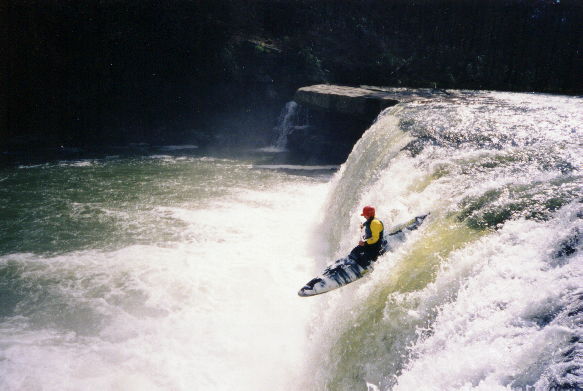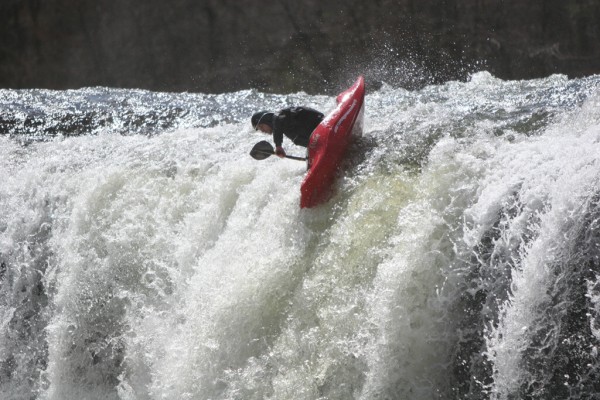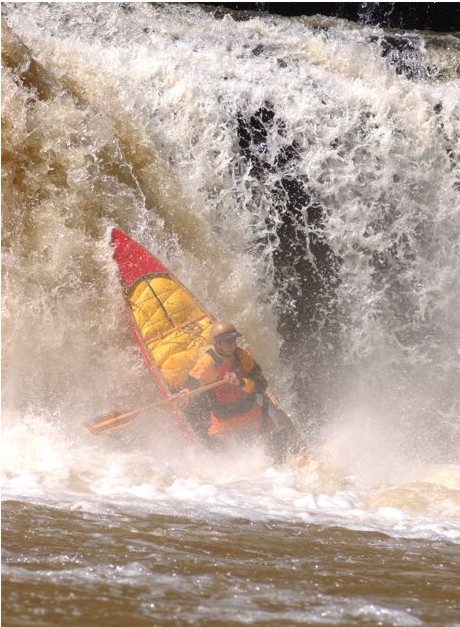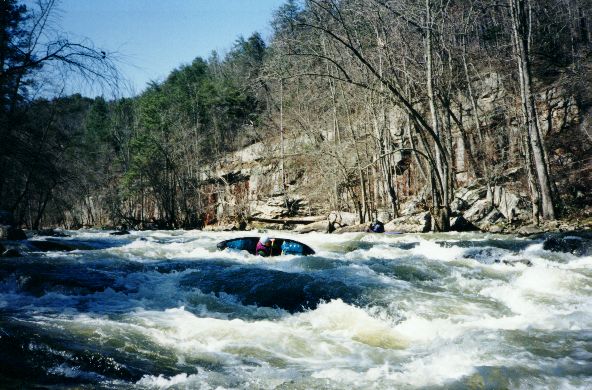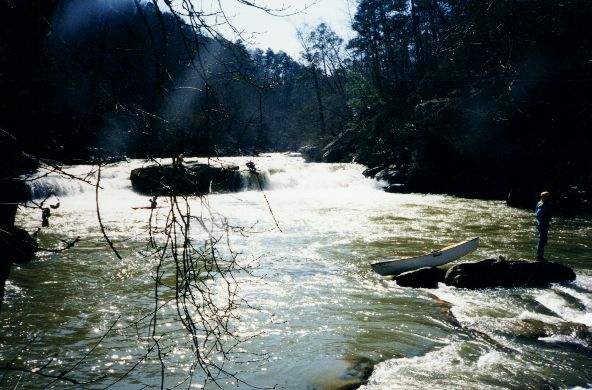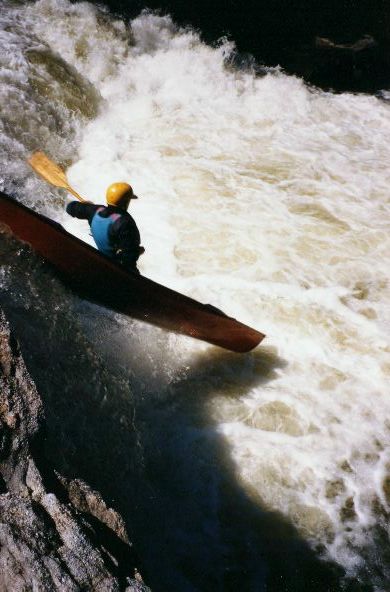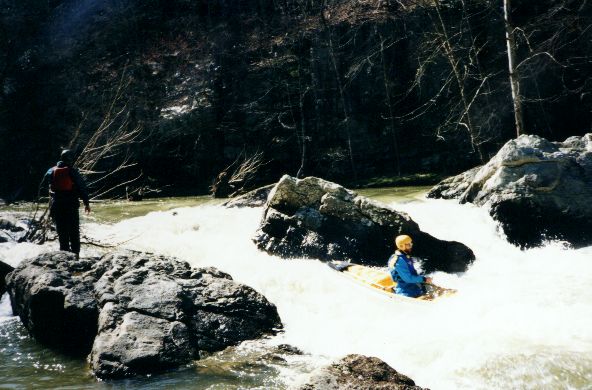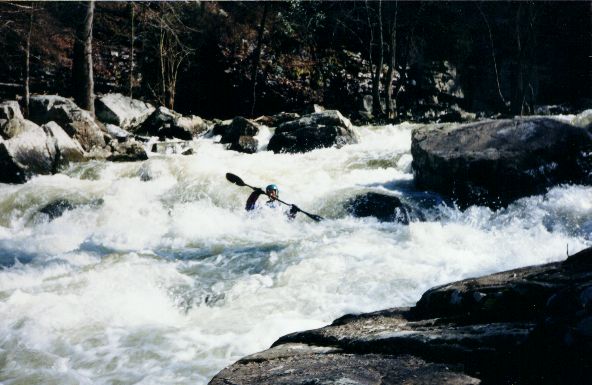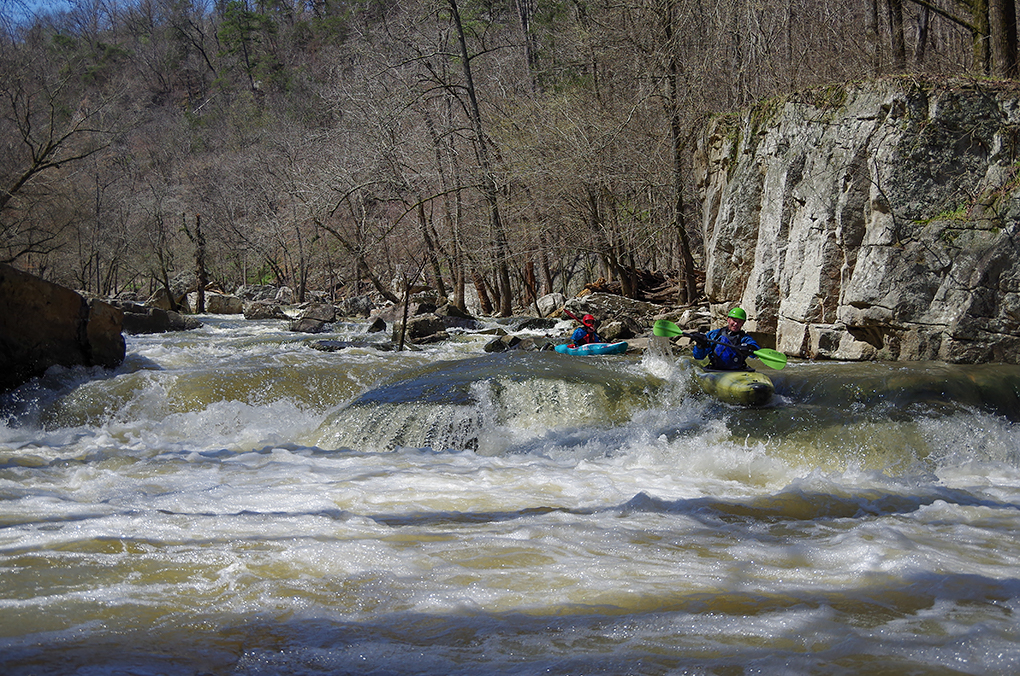Short Creek Lower
-
RunShort Creek
-
ClassIII / IV
-
Put InCR 409 Martling Rd
-
Take OutLake Guntersville Rt. 227
-
Length (mi)5.2 (+3 on lake)
-
Gradient (fpm)20, 40, 90, 80, 15
-
Watershed (mi2)91
-
Primary Gage
- StreamBeam Short Creek 0.5 ft.
- AL 75 Bridge Gauge 6 in.
-
Indicator Gage
Description
Short Creek has a squeaky-clean 18-foot waterfall, a thick stack of quality rapids and relatively straightforward (though strenuous) access logistics. Some people find fault with the water quality, a few manky sections, and the non-trivial lake paddle but despite this Short remains a favorite Alabama run and deserves strong consideration in any weekend of boating. In addition to the whitewater, the wildlife can also be interesting. A friendly goat, a pack of fluffy dogs, deer, coyotes, herons, and even eagles have been spotted at various points. Upper Short affords a nice 1 hour warm-up before the steep section and is a better parking option considering the rash of break-ins that have occurred on the other bridges. At the Martling Road bridge, the run begins with mellow class II warmup with a few III's at higher water. Downed trees are the main obstacle here; river wide log jams are common and some small slot rapids sometimes harbor wood. After two miles of easy water, another bridge comes into sight, signaling the approach of the main event: Short Creek Falls. Eddy out on the left downstream of the bridge, before the river left wall becomes a bluff blocking your exit.
The falls are very friendly and can be run just about anywhere that has water going over. Depending on where you go it's an 18 or 20 foot drop. The traditional line is about 10 feet off the left bank. Just don't go too far left, because if you land on the wrong side of the boil at the bottom, it will shove you into the mildly undercut shelf on the bottom left, where an amusing display of carping will likely ensue. Set safety from on top of this shelf. Eddy out behind it, hike back up and run it again. You can paddle behind the falls on the river right side, and watch your friends go over from behind the curtain. Pretty neat. After you get bored of the falls, a few class II-III boogie rapids follow. Keep an eye on the scenery ahead; when you see a sheer cliff face ahead on the right as the river bends left, Grotto Falls is coming up. Following a small slide and ledge combo, beach yourself on the large rock outcropping that divides the flow to scout Grotto. The main line is just a couple feet to the left of the rock you landed on, an easy 8- footer with big boof potential. At low water, keep your boat angled right to miss a piton rock on the left side of this drop. This can also be run further river left as a double drop, just stay away from the undercut bank.
Immediately following Grotto Falls is the infamous Tornado Sluice, which has caused many swims over the years. The line is down the turbulent left channel, entering from either side of a rock which divides the flow. You want to be on the right side of the chute as you finish off, angling downriver, to avoid the recirculating eddy and rock wall at the bottom left. If you get pushed into the wall, just ride it out and roll up before the creek gets too shallow.
After the triple stack of Grotto, Tornado Sluice, and Divided Highway, the action continues with Rock Cruncher, perhaps the biggest rapid after the falls. Catch an eddy on the left above the entrance to scout the full rapid. If it isn't an ELF day you can sneak down the left side, bouncing off a few rocks and into the pool below the rapid. The usual line is to work from center to right into an eddy on the right bank above the main drop; from here the line is down a chute headed back center to miss the big boulder on the right bank. No doubt you'll spot a juicy mushroom of water at the bottom ripe for a boof, but watch out! A nasty flake rock is right in the center below the mushroom. Skim the left or right side to avoid getting crunched.
A few easy rapids follow Rock Cruncher. The next significant rapid starts after a long pool, where the river doglegs right and the left and center are obscured by large boulders. The creek widens significantly here and you'll bump and scrape through the top part of this rapid, which has a few possible routes; the most entertaining option is a tight 3' boof against the far left bank. When the creek begins to channelize again, be wary as the majority of the current barrels down into Little Woodall, a dangerously sticky hole which is known to recirculate boats and swimmers. The safe line is to power into the eddy to the left of the hole, beside an enormous rectangular rock, then wheelchair down the rocks which form the pool on the downstream side. The more adventurous may wish to run the hole off the left shoulder, but be prepared to set safety if anyone plans on doing so.
After Little Woodall, a congested boogie rapid leads to the confluence with Scarham Creek. Hike up and take a look at the last rapid on this tributary, known as Terminator (class IV or V), and run it if it looks good to go. Below here the creek widens significantly, and with the added flow from Scarham, presents some good play opportunities to celebrate finishing the hard stuff. Surf waves and fun boofs abound. In the old write-up Mark D. mentioned a good ender hole in the 2nd rapid past the confluence on river right, best at low water. On the last rapid before the lake, you can find a fun boof in a ditch on far river right if you look hard enough. The last eddy line on river left (or is it lake left?) is also good for stern squirts. Once you reach the flatwater, celebrate the fact that you made it down the notorious Short Crick, and prepare yourself for the 45-minute, 3-mile paddle out. Just follow the channel all the way to the boat ramp. When the lake doglegs to the left for the first time, don't get too close to the island or you'll run aground. On the right shore of the dogleg, Dry Creek comes in. It's easy to hike up and get a look at the last few rapids, if you're interested in running it.
Access Notes:
The listed address for the put in is approximate - look for a bridge over the creek with a gravel pull off on the river left, downstream side. It is tempting to park at the Hustleville Road bridge to cut off the warmup rapids, but there are no parking signs on both sides of the bridge. If the water is high and you want a more interesting warmup, Drum Creek is a tributary which enters just above the falls and offers some nice class III water. See Alabama Whitewater for a description.
Gauge Notes:
The online gauge is operated by StreamBeam, a non-profit founded by a group of Alabama locals. The Streambeam gauge has recently been replaced in a new location, after the first was washed away in a flood. The new gauge has been installed at the Martling Rd. put-in, and features a stick gauge as well to verify the level in-person. The new gauge appears to correlate almost exactly with the AL 75 bridge gauge at low to medium flow ranges; look for at least 0.5' for a low run, 1' for good water, and above 2' would be high. The correlation is still being solidified, so please submit any visuals to Streambeam, and access the gauge below:
The TVA Town Creek gauge can be a backup indicator of whether Short Creek is running. If Town is over 400 CFS, there is a good chance Short will also be running, as it's the next watershed over from Town.
The old painted gauge is on the river-right, downstream side of the upstream span (there are 2 spans) of the AL 75 bridge. It reads approximately the same of the StreamBeam gauge.
For what it's worth, we've run it at 4-5" on the AL 75 gauge and it was still doable and fun. A few rapids downstream of the falls required some creative maneuvering to run, but we didn't have to get out of our boats.
- write-up provided by Kellis Kincaid, with edits by Gaylon Partain and Mark D.
Details
-
ClassIII / IV
-
Gradient (fpm)20, 40, 90, 80, 15
-
Length (mi)5.2 (+3 on lake)
-
Watershed Size (mi2)91
-
Put InCR 409 Martling Rd
-
Take OutLake Guntersville Rt. 227
-
ShuttleCR 409 / CR414 / Rt. 227
-
Water Quality
 (
3 chickens | 1 = Good, 3 = Gross)
(
3 chickens | 1 = Good, 3 = Gross)
-
Primary Gage
- StreamBeam Short Creek 0.5 ft.
- AL 75 Bridge Gauge 6 in.
-
Indicator Gage
-
Precip. Gage
Map
Video
Photos
Trip Reports
A Long Day on Short Creek
February 20, 1999
Written by Dave Curry
When we saw the mutilated cow on the creek bank, I knew we were in for an unusual trip. The aliens had obviously done a surgical job that had totally terrified the poor beast. The skin had had been scraped clean of hair, his entrails removed, and the eyeballs were popped so far out of the skull they looked like tennis balls. When Dave Branham and I met John Ellis at Hardee’s I was hoping that we would have at least some vestige of adult supervision for the planned Sand Mountain excursion; it was not to be. Mark D’ was busy, Gary Holder was unavailable, and John Parker was nowhere to be found. We were to be left to the guidance of Dave and our own devices. Dave was eager to paddle Short and I had no objections. It took a few minutes of persuasion to get John to acquiesce. We headed for the put-in.
We had only been paddling for a few minutes before we encountered the mutilated cow. A couple hundred yards downstream, we had our first anomalous event: John got into a wrestling match with a tree trunk. Quick thinking and the exercise of a little rescue training on Dave’s and my part spared him a watery fate.
The first major obstacle on the creek is Short Creek Falls: a “straight over” 22 foot (editors note: maybe 18') waterfall. This being John’s and my first trip on the creek, we decided to walk it. Dave, the “Master of Waterfalls”, opted to show us the correct line for our next run. After watching Dave’s run, I have wondered how it is possible to turn a boat upside down and get out of it, all while falling 22 feet. Dave ended up on the right bank of the creek and his boat on the left bank. An accurate throw with my rope and a good swim on Dave’s part got the two back together again. All we had to do was wake John up (he had fallen asleep on the rocks at the top of the falls) and we were on our way again.
All three of us had good runs on Grotto Falls. John and I landed upright at the bottom of the 10-foot drop while Dave performed a masterful combat roll after his pencil point run. It was pretty slow going all the way down through the major rapids. We spent quite a while bank scouting each one as we came to it. I had a couple of mandatory self rescues while John had the foresight to walk a couple of the nastier ones. On one of the drops Dave and I both hit a rock really hard with the back ends of our boats. Unbeknownst to me, it would later prove to be a real problem.
The last rapid before the confluence with Scarham Creek is a several hundred yard long constricted eddy-hop with random boulders and pour-overs. I started down the right hand side. As a left handed paddler, this created some problems (most of the eddies were on my right); it seemed that my boat was getting heavier and heavier and more squirrely with each passing second. When I was almost to the bottom, I hit a rock and turned over; I quickly rolled back up, but didn’t quite regain control before I ran over a small pour-over into a hole. I was upside down in a heartbeat. One roll attempt spun me like a top and left me upside down again. At this point, I decided to pull the cord and eject. I popped up in a white foamy world. The water was so aerated, I could barely keep my head above it. I tried to swim to the eddy. I felt this giant hand pulling me toward the base of the pour-over. I didn’t quite get there; the current jerked me straight down and then popped me up about ten feet downstream. I tried swimming again and got a repeat performance from the hole. I did manage to see Dave about 25 feet away getting his rope out to help me. I saw him throw the rope. I saw a red bag a few feet from my head. I grabbed it. It was my dry bag that had been beaten out of my boat by the thrashing water. Dave’s throw had missed me. I threw the dry bag at Dave. The hole gave me another dunking. Dave threw the rope again. This time he hit me and pulled me to safety. Now only my boat was left to save. The boat bounced and bobbed, rolled and turned, but it didn’t come out. Dave tried the patented Branham “toss the rope into the cockpit and jerk the boat out” technique. It didn’t work. I tried to get next to the hole and grab it. I couldn’t reach it. We just hopelessly watched the hole have its way. Just as I was about to give up and start walking, the hole grabbed the end of the boat, sucked it into its yawning maw and appeared to swallow it completely. An instant later, the hole burped and regurgitated it out and over the event horizon and into the eddy where we grabbed it.
A minute later, I was back aboard and paddling downstream. Again I noticed that the boat was feeling sluggish, and I felt water around my feet. I stopped to check things out. It was at this point that we noticed the huge dent (as big as a soccer ball) in the back of Dave’s boat and a foot long crack in the rear of mine. My boat was leaking like a sieve. Half a roll of duct tape later we were again on our way. We only had two miles of flat water to negotiate. My boat was leaking, I was tired, I had somehow bruised some ribs, and we had a headwind. It took forever. We made the takeout just before dark. I drove home, dumped my gear in the garage, I think I ate, and then crawled into bed.
